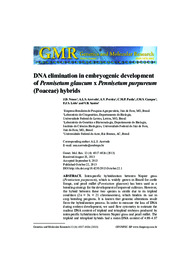DNA elimination in embryogenic development of Pennisetum glaucum x Pennisetum purpureum (Poaceae) hybrids.
DNA elimination in embryogenic development of Pennisetum glaucum x Pennisetum purpureum (Poaceae) hybrids.
Author(s): NUNES, J. D.; AZEVEDO, A. L. S.; PEREIRA, A. V.; PAULA, C. M. P.; CAMPOS, J. M. S.; LEDO, F. J. da S.; SANTOS, V. B.
Summary: Interspecific hybridization between Napier grass (Pennisetum purpureum), which is widely grown in Brazil for cattle forage, and pearl millet (Pennisetum glaucum) has been used as a breeding strategy for the development of improved cultivars. However, the hybrid between these two species is sterile due to its triploid condition (2n = 3x = 21 chromosomes), which hinders its use in crop breeding programs. It is known that genomic alterations result from the hybridization process. In order to measure the loss of DNA during embryo development, we used flow cytometry to estimate the nuclear DNA content of triploid and tetraploid embryos produced by interspecific hybridization between Napier grass and pearl millet. The triploid and tetraploid hybrids had a mean DNA content of 4.99-4.87 and 5.25-4.84 pg, at 10 and 30 days after pollination, respectively. The mean reduction in DNA content was higher in the tetraploid hybrids. The flow cytometry results revealed progressive genomic instability in these triploid and tetraploid hybrids, with this instability causing significant alterations in the DNA content of the hybrids.
Publication year: 2013
Types of publication: Journal article
Unit: Embrapa Dairy Cattle
Keywords: Elephant grass, flow cytometry, grasses, hybridization
Observation
Some of Embrapa's publications are published as ePub files. To read them, use or download one of the following free software options to your computer or mobile device. Android: Google Play Books; IOS: iBooks; Windows and Linux: Calibre.
Access other publications
Access the Agricultural Research Database (BDPA) to consult Embrapa's full library collection and records.
Visit Embrapa Bookstore to purchase books and other publications sold by Embrapa.

